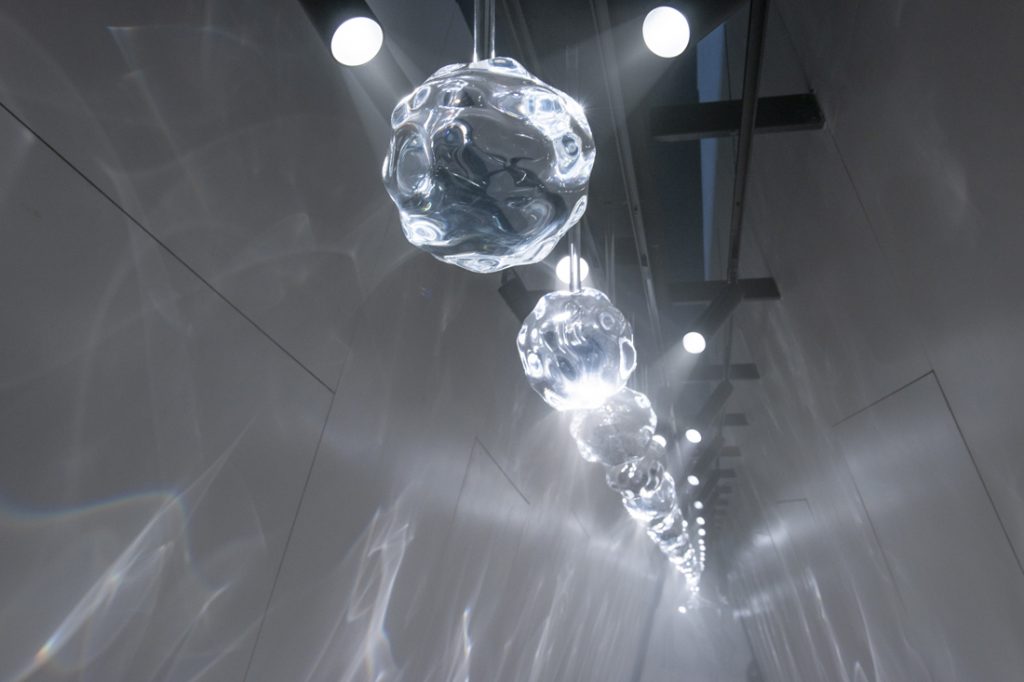Immersion in a surface material is possible! Benjamin Hubert of LAYER shows how using Dekton and light in poetic installation for Cosentino in Milan.

Photo by David Zanardi
April 11th, 2019
Following a successful preview during the recent Madrid Design Festival 19, Raytrace – designed by Benjamin Hubert of LAYER for Cosentino – now exhibits at Milan Design Week 2019. The immersive architectural installation showcases the material qualities of Cosentino’s Dekton surface material and how it can come to life with light.
Exhibited in the historic vaulted warehouses beneath the Central Train Station, Raytrace is a 25-metre-long, six-metre-high triangular passage composed of 380 square metres of the ultra compact surface Dekton Slim, with a thickness, or rather thinness, of only four millimetres. Seemingly balanced on a single edge within the dark atmospheric tunnels of Ventura Centrale, the surfaces create a large passageway that visitors can walk through.

Photo by David Zanardi
Upon entering the passageway, a mesmerising caustic pattern – made possible by 29 glass spheres and 87 LED lights – slowly dances across the surface, emulating light refraction through water. The effect gives visitors the sense of being underwater without the need for scuba-diving equipment nor the ability to swim. They also become part of the installation when their shadows are cast against the structure’s surface. Two mirrors at either end of the vault reflect the installation, further creating the illusion of an infinite space.

Photo by David Zanardi
Drawing inspiration from Dekton’s creation process when designing Raytrace, Hubert ultimately put the element of water back onto the material with a caustic optic effect. “The extraction of water using extreme heat and pressure throughout the manufacturing process is what makes Dekton a durable material most suited for architecture. Raytrace is a direct response to this method,” says Hubert. “But the most important thing about Raytrace is how it makes people feel. We encourage people to touch it, to interact and really experience the properties of Dekton.”

Photo by Jose Santopalomo
A powerful combination of design, nature and emotion, “the installation not only demonstrates the versatility of Dekton, but we hope that it can inspire architects and designers to think about the future of architecture and use our material in new ways,” says Santiago Alfonso, Vice President of Marketing and Communication at Cosentino Group.
If you’re in Milan, experience the installation at Ventura Centrale, Via Ferranti Aporti 27.
INDESIGN is on instagram
Follow @indesignlive
A searchable and comprehensive guide for specifying leading products and their suppliers
Keep up to date with the latest and greatest from our industry BFF's!

A curated exhibition in Frederiksstaden captures the spirit of Australian design

London-based design duo Raw Edges have joined forces with Established & Sons and Tongue & Groove to introduce Wall to Wall – a hand-stained, “living collection” that transforms parquet flooring into a canvas of colour, pattern, and possibility.

Guests joined Cosentino for a behind-the-scenes look at The Block homes, discovering new materials and creative partnerships.

Cosentino introduces Éclos®, a new mineral surface brand featuring zero crystalline silica, high recycled content and Inlayr® technology that brings 3D layered realism to design.
The internet never sleeps! Here's the stuff you might have missed

Luchetti Krelle’s timeless design at Epula marries heritage grandeur with classic sophistication, celebrating the spirit of a European piazza whilst remaining unmistakably of its place.

COX Architecture and Yerrabingin reveal the design for Canberra Lyric Theatre — a world-class, inclusive venue for the nation’s capital.